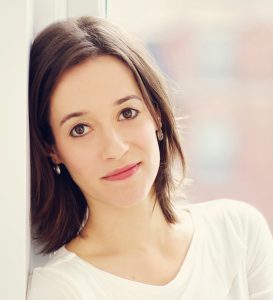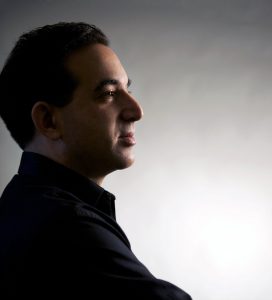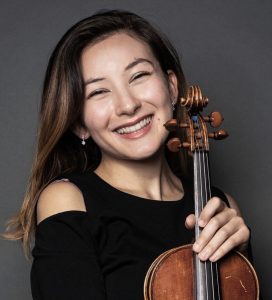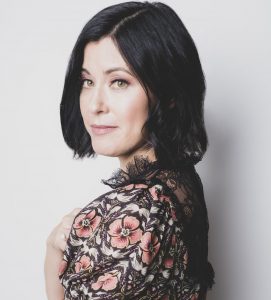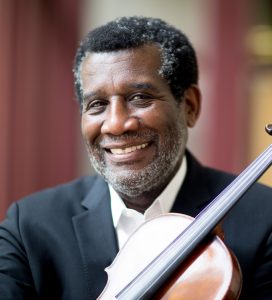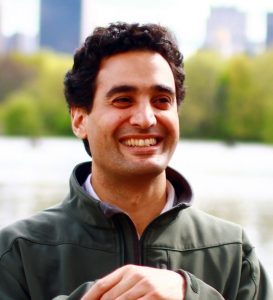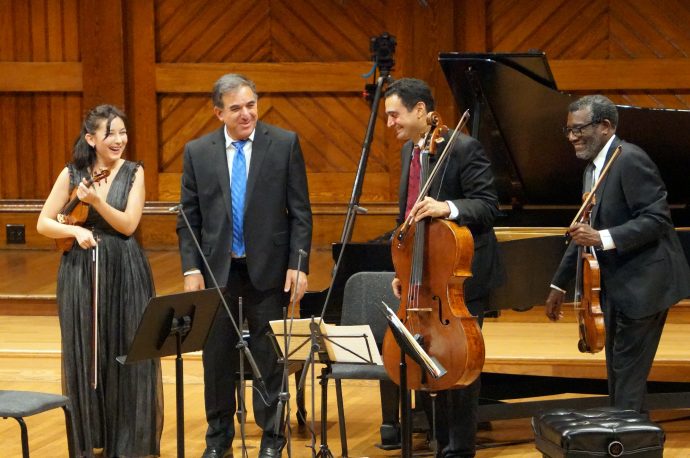Clara Schumann Three Romances, Op. 22 (1853)
Peggy Pearson, oboe; Max Levinson, piano
Johannes BRAHMS Piano Quartet No. 3 in C minor, Op. 60 (1875)
Isabelle Ai Durrenberger, violin; Marcus Thompson, viola; Raman Ramakrishnan, cello; Max Levinson, piano
Marion BAUER Concertino for Oboe, Clarinet, and String Quartet, Op. 32 (1939–44)
Peggy Pearson, oboe; Romie de Guise-Langlois, clarinet; Isabelle Ai Durrenberger, violin; Jennifer Frautschi, Marcus Thompson, viola; Raman Ramakrishnan, cello
Amy BEACH Piano Quintet in F-sharp minor, Op. 67 (1907)
Jennifer Frautschi, violin; Isabelle Ai Durrenberger, violin; Marcus Thompson, viola; Raman Ramakrishnan, cello; Max Levinson, piano
Clara Schumann’s Three Romances, her final contributions to the chamber music literature, feature long, lyrical lines in the treble voice that contrast with the florid piano writing.
Brahms’s Piano Quartet No. 3 in C minor is famously marked by the intrigue of unfulfilled love. A falling two-note motive akin to a sigh opens the first movement Allegro before a storm of ardent and tortured emotions ensues. Each of the four movements spotlights an instrument in the ensemble, the cello most memorably singing out a sublime love song in the Andante.
Having explored numerous tonal approaches throughout her career, Marion Bauer made use of a broad palette of harmonic colors in the Concertino for Oboe, Clarinet and Strings. The first two movements, meandering and moderate in tempo, find contrast with the rhythmic momentum of the final Allegro giocoso.
Amy Beach’s Piano Quintet in F-sharp minor opens with a dark Adagio introduction, music befitting the composer’s association of that key with the color black. A soft, romantic melody in the first violin brings a gentler character to the second movement, while the final Allegro agitato impresses with quick scalar runs.
Featured musicians
Full Program Notes
Clara Schumann
(September 13, 1819–May 20, 1896)
In 1850, Clara and Robert Schumann moved to Düsseldorf when the latter became music director of the city. Clara primarily performed, but the Op. 22 Three Romances (originally for violin and piano) came about at the end of a particularly productive summer as the Schumanns now lived in a house large enough for Clara to compose and practice without colliding with her husband’s work. It was during this time that Clara established friendships and collaborations with both Johannes Brahms and violinist Joseph Joachim (1831–1907), who is the dedicatee of Op. 22. The following year Robert Schumann would be hospitalized in February after a suicide attempt, and Joachim and Brahms both were devoted friends to Clara through Robert’s illness and after his death. She and Joachim toured with the pieces, including performing them for King George V of Hanover who reportedly adored them. The publication of the opus was delayed until January of 1856, thwarting Clara’s plans to offer it to Joachim as a Christmas gift.
Each of the three Romances demonstrates her attention to form, with more energetic middle sections flanked by lyrical bookends. The set opens with an Andante molto in 3/8, featuring a pathos-filled melody in the oboe supported by lush, yet gentle, piano writing. In both the second (marked “Allegretto” in G minor) and the third (marked “Leidenshaftlich schnell” in B-flat major) Romances, the piano has increased thematic responsibility, while the composer makes use of trills, grace notes, and thoughtful articulations to vary the texture. The piano’s role is highlighted in the middle section of the third Romance, particularly as most oboe arrangements omit the passages of violin pizzicato in the original.
Three Romances constituted the second and last formal chamber work of Clara’s oeuvre (the other being the Op. 17 Piano Trio of 1846), given that she returned primarily to performing after her husband’s death.
Johannes Brahms
(May 7, 1833–April 3, 1897)
This quartet is sometimes referred to as the “Werther” quartet, an ascription that stems from Brahms’s comment about Op. 60: “Imagine a man about to shoot himself…a man in blue and yellow.” Brahms’s allusion to Goethe’s forlorn and lovesick artist who commits suicide in the face of an impossible love with a married woman makes it tempting to impose an autobiographical program on the piece.
The opening of the Allegro is striking with a pronounced octave C in the piano, followed by a sighing figure that unfolds into what Eric Sams in 1971 identified as the “Clara” motive (here transposed): E-flat–D–C–B–C. The movement is in sonata form but holds various surprises, not the least of which is the recapitulation of the second theme in G major (instead of reaffirming the tonic). In its first appearance in the exposition, Brahms also fashions the secondary thematic area as a short theme and variations, with the theme heard primarily in the piano against various rhythmic figurations in the strings. When the viola brings back that theme in the recapitulation, it is hard not to hear a certain nostalgia in the major key. Brahms offers a dramatic transition to an extended coda, which ends with a return to the movement’s somber pathos.
The Scherzo is a marvelous, yet brief, foray into Brahms’s ideas of developing variation, wherein most of the content is interrelated, yet boldly asserts itself as new. The fiery C minor opening fashions itself on leaping descending octaves in the piano against staccato commentary in the strings. A brief and surprisingly graceful passage in the strings, then echoed by the piano, momentarily halts the scherzo’s panache. The piano quickly takes up the moto perpetuo energy again, which remains omnipresent in one form or another in the remainder of the movement. The ascending “trio” theme heard in the homophonic strings over the eighth notes in the piano has already been introduced in various guises against the motoric rhythms, so this section isn’t as self-contained and contrasting as one might expect in a typical scherzo. Instead Brahms explores the textures created by transferring the rhythmic responsibility to different groups of instruments. The scherzo soon returns, galloping toward an emphatic cadence in C major.
The gentle syncopations and dolce figures of the Andante obscure the fact that the movement is in E major, a remote key from C minor. The work was originally meant to be in C-sharp minor, which would more likely anticipate an E major contrast. However, as James Webster notes, Clara Schumann, upon hearing the work in 1875, clarified that the last two movements were new, whereas the first two had been composed earlier (likely in the 1850s). Regardless of its key, the opening cello theme offers an intensely beautiful entrée into an extended ternary form movement full of quiet gestures that blossom in texture and build in intensity. The movement ends with a brief recollection of the opening theme in the cello before landing tenderly on an E major chord.
The first theme heard in the violin solo of the Allegro comodo provides most of the material for the rest of the movement. The opening piano accompaniment is unabashedly based upon the opening of Mendelssohn’s Piano Trio No. 2 in C minor, Op. 66, and also provides thematic material for the movement. In the relative major (E-flat), the violin and viola render a legato version of the piano theme in unison before Brahms transforms the sinuous lines heard in solo strings into mezza voce chorales, closing out the repeated exposition. The entire development (marked Tranquillo e sempre pianissimo) works with the thematic material in different guises and articulations, introducing ideas that are new, but still derived from the themes of the exposition. The recapitulation is initially somewhat developmental as well, but settles back into presenting the main themes. A majestic chorale in the piano signals the coda, which offers a snapshot of the main ideas of the movement before briefly revisiting C minor, only to be trounced upon by a final C major cadence.
Marion Bauer
(August 15, 1882–August 9, 1955)
Born in Walla Walla, Washington, Marion Bauer’s musical studies included locales such as Oregon, Berlin, and Paris, where she worked with Nadia Boulanger. It was twelve summers spent at the MacDowell Colony between 1919 and 1944, however, where she would meet other important composers such as Miriam Gideon, Ruth Crawford, and notably, Amy Beach. She taught music history and composition at NYU from 1926 until 1951, and was affiliated with Juilliard from 1940 until her death. Bauer was a staunch advocate for American music and composers, and held leadership positions in the Society for the Publications of American Music, the League of Composers, as well as the American Composers Alliance, and was a founding member of the American Music Guild. She participated in the Society of American Women Composers, founded in 1911 by Amy Beach.
As a composer she was grouped in with the modernists in the 1920s, but was seen as more conservative by the 1940s. The Concertino offers a well-crafted sense of cohesion throughout, with sensitive writing for the varied timbres of the ensemble.
In the Allegretto, the melody that begins in the oboe is transferred to the clarinet and eventually to the violin—never repeated wholesale, but motivically connective and perpetuating a lyricism with a modern sensibility. The characteristic rising fifth carries through to the middle section, started by the clarinet, with a theme that is closely related to the opening melody. Bauer offers a dotted rhythm as the next motivic signal, skillfully maintaining a sense of flow and melody while peppering the motive across the voices. The application of mixed meters allows the melody to drive the movement. A short, homophonic coda of sforzando chords augments a motive heard briefly earlier in the movement, closing with final references to the dotted rhythm and other derived material.
The viola’s first gesture in the Andantino picks up the ascending fifth interval from the preceding movement, but it descends into a tritone, casting a more melancholic guise. When taken up by the oboe, the chromatic and syncopated descending line that slows the theme offers a momentary mournfulness, but as in the opening movement, the texture across the ensemble is constantly in motion, never wallowing. The energy changes with more pointed articulations in the viola and oboe, as well as dynamic contrasts. The tripleted quarter-eighth note motive becomes the primary focus, dissolving into an oscillation before the opening motive is referenced again in the oboe, albeit now ending in a perfect fifth, with counterpoint in the clarinet and homophonic strings. The final sounding of the motive is in the first violin that plays a more diatonic version followed directly by the descending tritone version, tying together the two “faces” of the motive. The final measures slow into a fermata before the Allegro giocoso begins attacca. In conspicuous contrast to the first two movements, the final movement is impishly dancelike and harmonically adventurous. The winds get a quasi-cadenza, starting with a reference to the second movement’s motive. The final measures offer a true sense of synthesis to the work as a whole.
Amy Beach
(September 5, 1867–December 27, 1944)
The Piano Quintet was first performed in Boston on 27 February 1908 by the Hoffman String Quartet with the composer at the piano. Born in New Hampshire, Beach (née Cheney) moved to Chelsea, then Boston as a young girl. Considered a musical prodigy, she very quickly materialized on the radar screen of the Cambridge elite, including Oliver Wendell Holmes and H.W. Longfellow. Celebrated during her lifetime as the “foremost woman composer of the United States,” she made her Boston piano debut in October 1883 and her BSO debut in March of 1885, playing the Chopin Piano Concerto No. 2 in F minor. That same year she married physician and amateur singer Henry Harris Aubrey Beach, prompting her use of “Mrs. H.H.A Beach” on concert programs and compositions.
While she did receive some instruction in harmony and counterpoint with Junius Hill, Beach was largely self-taught through a rigorous ten-year examination of previous masterworks. The Piano Quintet is deemed to be one of Beach’s most esteemed compositions, having been heralded by critics at its premiere as a very important contribution to the quintet repertoire. Beach performed the work many times, including on tour with the Kneisel Quartet.
Her Quintet demonstrates her familiarity with the cyclic approach found in Robert Schumann’s Piano Quintet in E-flat major, Op. 44 (1842), as well as Brahms’s Piano Quintet in F minor, Op. 34 (1864), both of which she had performed with the Kneisel Quartet. It is the latter work, however, that exerted a much more overt influence, as Beach’s Quintet is “in dialogue” with Brahms’s Quintet in a variety of ways, as explained by scholar R. Larry Todd. The most audible homage is heard in the opening movement. The Adagio opening is striking with its assertive piano flourishes against a sustained and ethereal F-sharp in the strings. Seemingly serving as a slow introduction, the somewhat somber and dissonant preface ends on a half cadence C-sharp major chord, offering a moment of harmonic grounding in the dominant key. The Allegro begins with rumbling arpeggiations in the piano and a lyrical melody in the first violin which is a clear reference to a theme from the finale of Brahms’s Piano Quintet. The chromatic descent from F-sharp to C-sharp outlined in the theme is an idea that resurfaces throughout the work. The aggressive energy of the opening measures returns, fully embodied in the ensemble. Beach continues to juxtapose the two characters until the secondary thematic area in B major emerges with cantabile two-octave figures in the piano and a chromatic descent down from F-sharp in the second violin. While the movement is in sonata form, the recapitulation is varied and inventive, returning once more to the sustained F-sharp in the strings. The final measures of the movement calmly cadence into a triple piano F-sharp minor chord.
The muted opening of the Adagio espressivo in D-flat major offers a more melodic and straightforward theme than those of the opening movement, though elements of Brahms’s theme are still present. The piano’s articulation of the theme heightens the Romantic pathos, and the middle section intensifies the chromaticism. R. Larry Todd notes that the harmonies here signify Beach “rapturously redirect[ing] her gaze backward to revive a fleeting, autumnal vision of the musical past from which she had first drawn her musical nourishment.”
The vivacious opening of the finale offers a main theme that seems occasionally lost in the whirlwind, but Beach calms the maelstrom with a theme in the viola before reiterated chords in the piano heighten the emotional intensity once more. A conspicuous tremolando fugue builds toward a reprise of the opening of the piece, with the translucent F-sharp in the strings over the bold piano figures. The Brahmsian theme is now uttered slowly by all the strings together in octaves and a final Presto coda recalls the descending F-sharp to C-sharp tetrachord in myriad ways, until the final two chords pronounce a resolute ending the F-sharp major.
© 2025 Rebecca G. Marchand

